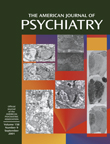To the Editor: Drs. Nagy and Loveland propose that the olfactory identification deficit in Alzheimer’s disease is a result of a general semantic categorization impairment (trouble naming odors or recognizing their names) and is not due to an olfactory memory deficit. However, evidence from a number of studies has clearly shown that the deficit in olfactory identification in Alzheimer’s disease is largely the result of impairment in olfactory memory. In an elegant series of experiments, Larsson et al.
(1) showed that patients with mild Alzheimer’s disease performed worse than matched healthy comparison subjects on four types of olfactory identification tasks, one of which involved the matching of specific smells to which the subject had been previously exposed without requiring him or her to name the smell. In our study of mild cognitive impairment, olfactory identification deficits accompanied by lack of awareness of these deficits predicted conversion to Alzheimer’s disease in Cox analyses (relative risk=5.91, 95% confidence interval=1.5–23.7, p<0.02), even after control for age, sex, education, and modified Mini-Mental State Examination (MMSE) and Boston Naming Test scores (data for attentional and memory measures but not the Boston Naming Test were presented in the article). This finding supports the view that the olfactory deficit in Alzheimer’s disease is not caused solely by a deficit in naming or semantic categorization. We agree with these authors’ view that olfactory evoked potentials are probably not likely to prove useful for potential clinical application in making the early diagnosis of Alzheimer’s disease.
We agree with Dr. Doty’s point that olfactory identification deficits are not specific to Alzheimer’s disease but are also present in Huntington’s disease and Parkinson’s disease. A critical point by Dr. Doty is that in an earlier study only two of 34 Alzheimer’s disease patients were aware of their olfactory deficit. These data provide independent confirmatory evidence to support some of our main findings. Finally, the suggestion that operational diagnostic criteria for Alzheimer’s disease should include MRI and olfactory criteria is intriguing, but more research to establish sensitivity, specificity, and positive and negative predictive value for these putative early diagnostic markers is necessary before such a step can be taken.
We thank Dr. Serby for pointing out that the word “detection” was erroneously used instead of “identification” in the reference in our article to family members of patients with Alzheimer’s disease. However, throughout the rest of our article, there was repeated mention of the fact that the deficit in Alzheimer’s disease is in the identification and not in the detection of odors, as has been established in the literature.
In our study, low olfaction scores in mild cognitive impairment predicted Alzheimer’s disease during follow-up, and low olfaction scores accompanied by lack of awareness of the olfactory deficit added unique variance to the prediction of Alzheimer’s disease after control for age, gender, education, and MMSE score. To assess awareness of difficulty in smelling, we used the Pennsylvania Smell Identification Test item that asks whether the subject has any problems smelling. We agree with Dr. Serby that this standard question in the Pennsylvania Smell Identification Test is ambiguous and that the subject can interpret it to mean problems in detecting or identifying smells or both. Future research on this issue should separate these two components to avoid potential ambiguity for subjects answering questions about their ability to smell.

